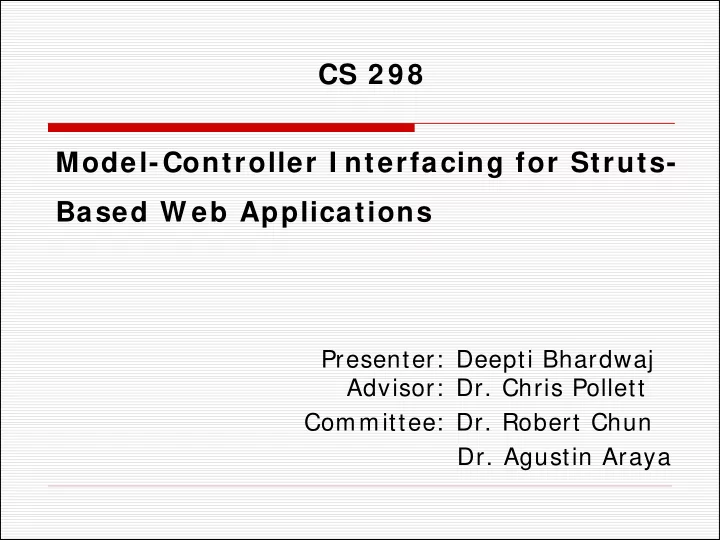

CS 2 9 8 Model-Controller I nterfacing for Struts- Based W eb Applications Presenter: Deepti Bhardwaj Advisor: Dr. Chris Pollett Committee: Dr. Robert Chun Dr. Agustin Araya
Outline • Purpose • Introduction • Background • Design and Architecture • Implementation • Performance • Usability Testing • Conclusion
Purpose • Traditional Desktop-based IDEs such as Eclipse and NetBeans. • Installation and configuration are required • User responsible for his workspace • Existing Web-based IDEs are Mozilla Skywriter or Bespin, and Aurorasdk IDE. • No installation is required • Can be used anywhere with internet connection
Purpose • Limitations of existing Web-based IDE • Need to write a lot of code • Need to set up the database schema for database- driven Web applications
Introduction – StrutsHib IDE • Our StrutsHib Web-based IDE allows users to develop Struts based web applications with minimal hand-coding. • It is developed using Java technologies: Struts, Hibernate framework, JSP and JavaScript • We have implemented jQuery Javascript framework for client-side features. • We have used the CKEditor which is a Web-based WYSIWYG text editor.
Technologies Used Struts • a Model –View-Controller (MVC) design pattern based framework • an open source Java framework and used to develop web applications Hibernate • a framework for mapping an object-oriented domain model to a traditional relational database • an object-relational mapping (ORM) library for the Java language
Technologies Used JQuery • an open source JavaScript framework • simplify the client-side scripting
Preliminary Work • File Creation application Goal: understand MVC architecture get comfortable with Struts Framework
Preliminary Work • W eb-based I DE “Aurorasdk” Goal: to study the architecture of a web-based IDE Technologies Used: Google Web Toolkit (GWT), Servlet and MySQL Lim itations: users require to do hand-coding does not provide cross-browser compatibility does not provide collaboration feature
Preliminary Work
Design Features of our StrutsHib I DE • Automatic setup of files, databases, and database tables • Creating New Model or Controller • Associating Models • Interfacing Model and Controller
Design • Directory Structure – Struts Application
Design • Struts Com ponent Action Class Files: stored under com.webide.struts.action Action Form Files: stored under com.webide.struts.beans struts-config.xml: placed under the Web-INF directory View Resources: placed under the Web Root directory
Database Design • MySQL database name web_ide is used for StrutsHib IDE • Database tables • Users (id, Name, Password, UserName) • Projects (id, projectname, projectpath, user_id) • Models (id, modelname, modelpath, project_id) • Models_Association (id, model_id1, model_id2, asso_type) • Controllers (id, controllername, controllerpath, project_id)
Architecture • When a user creates a new project, three subfolders gets created on the server. • Model • Controller • View
Implementation • When a user creates a new project, three subfolders gets created on the server i.e. Model, Controller and View. Returns the physical path on the server getServlet().getServletContext().getRealPath() • The folder is traversed stored in a string buffer. Request.setAttribute("ProjectUserName",Buffer); • In client side values can be retrieved by using < % StringBuffervalues= (StringBuffer)request.getAttribu te (" ProjectUserName"); % >
Hibernate Instantiation • SessionFactory is a immutable and thread-safe object for creating new Hibernate sessions • Session is intended to last as long as the logical transaction on the database. static { try { configuration.configure(configFile); sessionFactory = configuration.buildSessionFactory(); } catch (Exception e) { e.printStackTrace(); } }
Hibernate Initialization • Implemented SessionFactory using Singleton pattern • Lazy initialization is done public static Session getSession() throws HibernateException { Session session = (Session) threadLocal.get(); if (session == null || !session.isOpen()) { if (sessionFactory == null) { rebuildSessionFactory(); } session = (sessionFactory != null) ? sessionFactory.openSession(): null; threadLocal.set(session); } return session; }
Struts Configuration • Binding information for the different components of the Struts framework.
StrutsHib IDE
StrutsHib IDE Main Page
Design Mode – Edit Model • Right-click on model file gives an option to edit the model schema.
Associating Models • Models can be interfaced by creating associations between them • hasMany, hasOne, and belongsTo are the association types
Middle Panel – Edit Mode
Add Project, Models or Controllers • New project, model and controller can be created • On clicking “Create” button, JavaScript will send an Ajax call to the controller along with user inputs. • The controller will create the files on server and store the information in database.
Right Panel • Interactive Help panel is associated with the user action.
Performance 70 Thousands 60 50 40 Eclipse Time (ms) StrutsHib Time (ms) 30 Aurorasdk Time (ms) 20 10 0 Load Time Project Create File Open File Save File Creation
Usability Testing • Six users are asked to perform following tasks: Task 1 . Create a user account and login using username and password. Task 2 . Create your new project ‘TestProject’ and browse the files structure created by the StrutsHib IDE. Task 3 . Create a new model ‘TestModel’ under Model directory and open the file in the design mode. Task 4 . Edit the model schema by adding new fields to it using design mode editor. Task 5 . Create association between ‘TestModel’ model component and default model ‘TestProject’ using design mode editor. Task 6 . Create interfacing between ‘TestModel’ model and controller component ‘TestController’ using drag and drop feature.
Usability Testing 6 5 4 Expert Users 3 Novice Users 2 1 0 Task 1 Task 2 Task 3 Task 4 Task 5 Task 6
Usability Testing • Users found that our StrutsHib IDE simplifies the process of creating a project with its models and controller components. • Users evaluated it against other IDEs and found it easy to use and requires less learning curve. Observation • Less hand-coding increases productivity.
Conclusion • Achieved the goal of the project by implementing the IDE that automates the processes of creating Web application. • Our StrutsHib web-based application is user-friendly and it has features which help the user in rapid development of their projects. • Overall, users found our StrutsHib IDE easy to use. • StrutsHib IDE can be enhanced to support team collaboration.
Questions?
Thank you
Recommend
More recommend